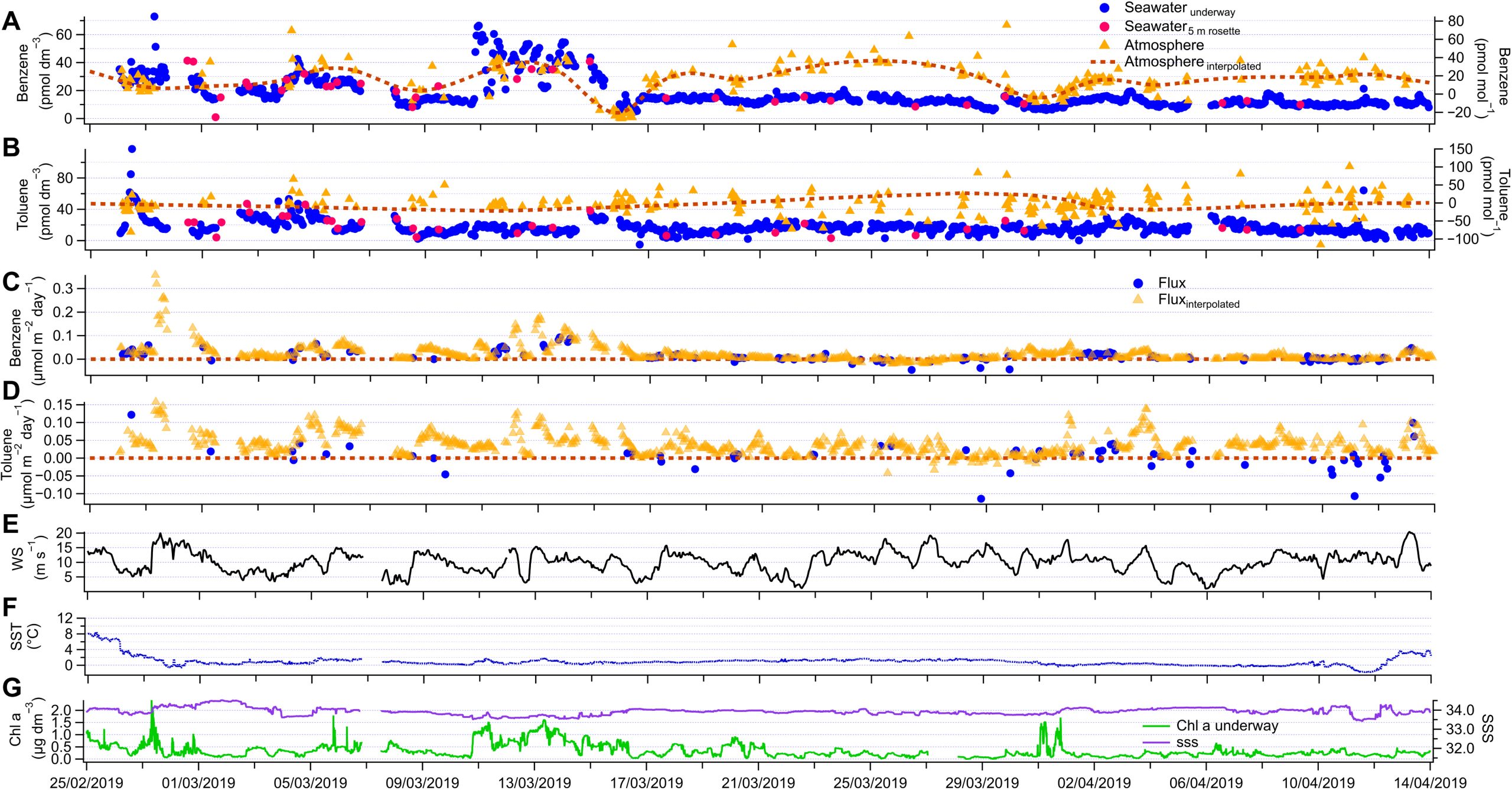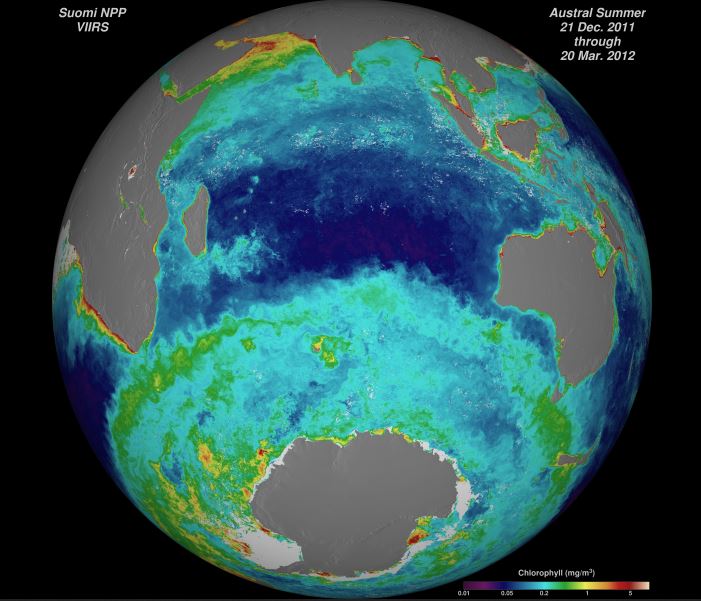The science is settled except we only just realized that the benzene and toluene gas over the vast Southern Ocean were not man-made pollutants after all, but were made by industrious phytoplankton. For the first time someone went and measured the benzene and toluene in the water and discovered that instead of being a sink for human pollutants in the air above, the ocean was the source.
This matters because these two gases increased the amount of organic aerosols by, wait for it, between 8% and up to 80% in bursts. And all that extra aerosol matters, of course, because aerosols seed clouds, which change the weather.
And the expert climate models, upon which a $1.5 Trillion dollar industry depends on for its’ very existence, did not know this. If hypothetically there has been less phytoplankton in the worlds oceans in the last few decades, there may also have been less cloud cover, and thus more warming. But who knows?
The modelers are always saying climate change can’t be natural because they can’t think of anything else that could have could have caused the warming, then people keep finding another factor they forgot to put in the models…
“In any case “climate models will have to consider benzene and toluene emissions from the oceans if they want to get the clouds right in climate projections for both the past and the future,” says IQFR-CSIC researcher and head of the atmospheric modeling part of the study Alfonso Saiz-López.”
This is an image of rolling eddies of blooms of phytoplankton in 2017 between the Antarctic peninsula and South America. Like a giant artist was marbling patterns in the worlds oceans.

Southern Ocean drives massive bloom of tiny phytoplankton 2017. On January 13, 2016, the Visible Infrared Imaging Radiometer Suite (VIIRS) on the Suomi NPP satellite captured this view of extensive phytoplankton blooms stretching from the tip of South America across to the Antarctic Peninsula.*
Does this sound like a mature field ready to have a $7 trillion dollar carbon market set up around it?
New study highlights the impact of two new marine gases on climate models’ accuracy
PhysOrg
“If we don’t get the clouds right, we won’t get the climate right,” says Charel Wohl, ICM-CSIC researcher and lead author of the study. “We are just beginning to unveil the multiple ingredients that form cloud seeds,” he adds.
The work, published in the journal Science Advances, describes the first measurements of benzene and toluene in polar oceans and indicates that these compounds have a biological origin. Until now, their presence in polar marine air was thought to be a proof of the extent of human pollution from coal and oil combustion or solvent use, among others.
A biological origin
The only way to know how the atmospheric composition was regulated before the profound changes generated by human activity in the industrial era is to study those regions where the air is still clean, such as the polar areas.
To carry out the study, the team measured the concentrations of benzene and toluene in surface water and air during the course of two oceanographic campaigns: one in the Arctic and the other in the Southern Ocean. The distribution of these gases, their relationship to the amount of phytoplankton, and the fact that the ocean was constantly emitting them into the atmosphere rather than capturing them from it, led the researchers to conclude that they were of biological origin.
Then, by incorporating the data into a global atmospheric chemistry and climate model, the scientific team realized that benzene and toluene emitted by the ocean contributed significantly to aerosol production. This was especially true in the extremely clean and unpolluted atmosphere of the Southern Ocean, where these two gases increased the amount of organic aerosols by 8% and up to 80% in transient situations.
The ocean is a net supplier — it’s outgassing far more than it absorbs
From the paper: Benzene is the top row, and clearly, in this two month period in 2019 there are big fluctuations, which could affect cloud cover (Click to enlarge. ) The fluxes of gases are shown in C and D and most of the time the ocean is neutral or outgassing.

Fig. 2. Underway measurements from the Southern Ocean.
Hourly underway surface seawater concentrations and atmospheric mole fractions of benzene and toluene in (A) and (B), respectively. Interpolated air mole fractions are also shown in (A) and (B). The calculated sea-to-air fluxes are shown in (C) and (D). Positive fluxes indicate ocean outgassing, i.e., sea-to-air fluxes. The other plots show the wind speed (WS) (E), underway sea surface temperature (SST) (F), and Chl a and surface seawater salinity (SSS) (G). https://www.science.org/doi/10.1126/sciadv.add9031
This unique combination of measurements points toward a biological source for these two compounds previously thought to be predominantly released to the environment from anthropogenic activity.
Chlorophyll concentrations marks out where phytoplankton were in a three month period. The highest concentration blooms are marked in red.
Secondary Organic Aerosols (SOA) may have a big effect on cloud formation:
Concurrent high-resolution measurements in the surface seawater and the overlying atmosphere showed that both the Arctic and the Southern Ocean were highly supersaturated in benzene and toluene, and their emission fluxes rivalled those of other atmospherically relevant marine trace gases, such as isoprene or monoterpenes, although the particle yield of benzene and toluene is much higher than that of previously well-researched marine trace gases. Implementing these ocean emission fluxes in a global chemistry-climate model, we estimated that ocean-leaving benzene and toluene made substantial contributions to SOA mass concentration in the polar regions, with the largest effect over the pristine Southern Ocean (7.7% increase in SOA as the average effect and up to 77.3% increase using the highest measured emission flux).
Our findings also call for expanding both the measurements and the model representations of other, hitherto overlooked, gas precursors of SOA in the marine atmosphere
If phytoplankton have more of a role controlling Earth’s climate, then CO2 has less of a role.
REFERENCE
Charel Wohl et al, Marine biogenic emissions of benzene and toluene and their contribution to secondary organic aerosols over the polar oceans, Science Advances (2023). DOI: 10.1126/sciadv.add9031
NASA Chlorophyll Concentrations in the Southern Ocean.
*Wikimedia. The image was built with data from the red, green, and blue wavelength bands on VIIRS, plus chlorophyll data. A series of image-processing steps highlighted the color differences and more subtle features, such as nearly a dozen eddies of varying sizes.
